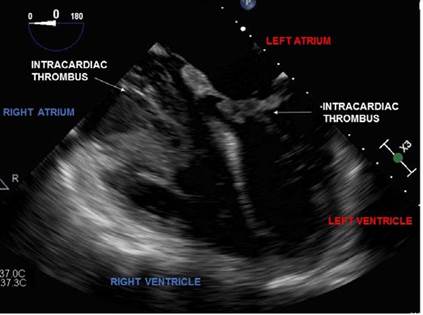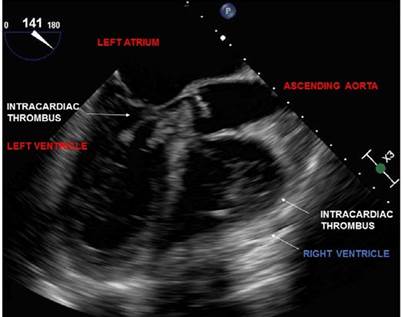What do we know about this problem and what does this study contribute?
Patients with Essential Thrombocythemia pose a variety of anesthetic challenges including a heightened risk of perioperative thrombosis. This condition is also associated with perioperative hemorrhage, risk for developing heparin induced thrombocytopenia type 2 during cardiac surgery and digital gangrene from radial artery catheterization.
What does this new study contribute?
While deep vein thrombosis leading to pulmonary embolism is not an uncommon phenomenon, clot formation in both the right and left heart chambers is rare. Pulmonary and systemic embolization of such clots can be devastating. Anesthesiologists may benefit from knowing about Essential Thrombocythemia, how it affects perioperative thrombohemorrhagic risk and what is unique about establishing cardiopulmonary bypass in these patients.
Essential thrombocythemia is a bone marrow clonal disorder characterized by thrombocytosis (platelet count > 450,000/microL) and a heightened risk for thrombohemorrhagic events. Thrombotic events include stroke, myocardial infarction and pulmonary embolism. Rarely, intracardiac thrombosis can develop.1,2
The accompanying echocardiography images demonstrate this circumstance. Clots can be appreciated in the right atrium and both the ventricles (Images 1and2). A large thrombus is seen in the pulmonary artery (Video). Interestingly, patients with extreme thrombocytosis (platelet counts >1 million/microL) develop acquired von Willebrand disease and are at risk of perioperative hemorrhage.
Diagnosing essential thrombocythemia necessitates a high degree of suspicion as patients often report nonspecific symptoms like fatigue or headache. Thrombocytosis in such patients may be inadvertently attributed to reactive thrombocytosis. Reactive thrombocytosis is benign and occurs secondary to infection, inflammation or malignancy; conditions which commonly affect surgical patients. Absence of reactive thrombocytosis and presence of persistent thrombocytosis should prompt work up for essential thrombocythemia. A hematologist should be consulted for assessing need for preoperative cytoreductive therapy or plateletpheresis with the goal being normalization of platelet counts prior to surgery 1,2.
Intracardiac thrombi necessitate emergent cardiopulmonary bypass (CPB) assisted surgical embolectomy. Patients are often hemodynamically unstable as increased pulmonary vascular resistance (PVR) from pulmonary thromboemboli precipitates acute right heart failure, impeding left ventricular filling and ejection. Additionally, left ventricular thrombi may embolize to coronary arteries leading to myocardial ischemia.
Anesthetic management focuses on optimizing cardiac output. Epinephrine and norepinephrine infusions help maintain inotropy and systemic perfusion while inhalational nitric oxide decreases PVR. Invasive arterial monitoring is preferably established prior to induction. As central line cannulation can lead to pulmonary embolization of right atrial thrombi, echocardiography guidance during placement is encouraged. Thrombocytosis induced heparin resistance may necessitate using larger bolus doses of heparin and/or cangrelor to achieve adequate anticoagulation prior to CPB institution 2,3
ETHICAL RESPONSIBILITIES
Protection of people and animals. No experiments on people or animals were done.
Confidentiality of the data. All protocols at our institute were followed and patient or hospital identifiers have been removed from all images.
Right to privacy and informed consent. As patient and hospital identifiers have been removed, no informed consent was solicited for this production.











 text in
text in 




